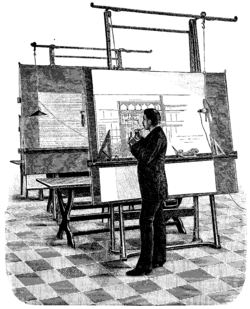**1. Origins and Evolution:**
– Architectural design historically done by artisans like stone masons and carpenters
– Development in technology and mathematics led to the emergence of gentleman architects
– The architect title comes from Greek for master builder
– Paper and pencils availability in the 15th to 16th centuries improved pre-construction drawings
– No clear distinction between architect and engineer until modern times
**2. Professional Practice:**
– Legal practice of architecture requires appropriate license, certification, or registration
– Representation as an architect is restricted to licensed individuals
– Architects can practice independently, unlike building design professionals
– Architects coordinate a design team throughout the project
– Non-licensed individuals may design smaller structures in some places
**3. Design and Specializations:**
– Architects create design concepts meeting client requirements
– Design proposals need to be imaginative and practical
– Architects specialize in various areas like residential, commercial, landscape, etc.
– Architects may work in teams with specialists from different fields
– Architects may work on interior design, urban planning, sustainable design, or historic preservation
**4. Technology and Environmental Considerations:**
– Architects traditionally used drawings for design proposals
– Computer technology has become the industry standard
– Modern buildings aim to reduce carbon emissions
– Designs incorporate renewable energy sources
– Focus on low energy use, passive solar design, and environmental sustainability
**5. Professional Requirements and Recognition:**
– Architects need to register with appropriate jurisdictions
– University degree in architecture is a basic educational requirement
– Experience is gained through internships or practicums
– Architects’ fees are based on construction value percentage, unit area rate, or hourly rates
– Professional organizations like the International Union of Architects and awards like the Pritzker Prize recognize architectural excellence.
This article needs additional citations for verification. (October 2014) |
An architect is a person who plans, designs, and oversees the construction of buildings. To practice architecture means to provide services in connection with the design of buildings and the space within the site surrounding the buildings that have human occupancy or use as their principal purpose. Etymologically, the term architect derives from the Latinarchitectus, which derives from the Greek (arkhi-, chief + tekton, builder), i.e., chief builder.
 An architect, 1893. | |
| Occupation | |
|---|---|
| Names | Architect |
Occupation type | Profession |
Activity sectors | Architecture Civil engineering Structural engineering Construction Project management Urban planning Interior design Visual arts |
| Description | |
| Competencies | Engineering, technical knowledge, building design, planning and management skills |
Education required | See professional requirements |
The professional requirements for architects vary from location to location. An architect's decisions affect public safety, and thus the architect must undergo specialized training consisting of advanced education and a practicum (or internship) for practical experience to earn a license to practice architecture. Practical, technical, and academic requirements for becoming an architect vary by jurisdiction though the formal study of architecture in academic institutions has played a pivotal role in the development of the profession.
English
Etymology
From Middle French architecte, from Latin architectus, from Ancient Greek ἀρχιτέκτων (arkhitéktōn, “master builder”), from ἀρχι- (arkhi-, “chief”) + τέκτων (téktōn, “builder”).